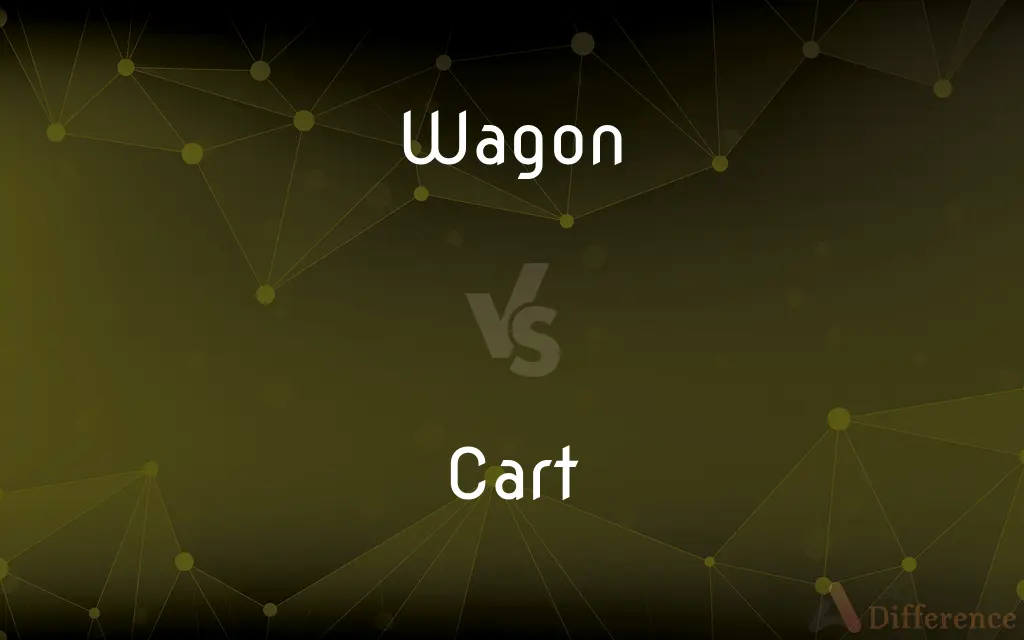Wagon vs. Cart — What's the Difference?
By Urooj Arif & Maham Liaqat — Updated on March 5, 2024
Wagons are four-wheeled vehicles for transporting goods or passengers, while carts are typically two-wheeled and pulled by one or more animals.

Difference Between Wagon and Cart
Table of Contents
ADVERTISEMENT
Key Differences
A wagon is a heavy, four-wheeled vehicle designed to transport goods or people. It's often pulled by animals such as horses or oxen and is characterized by its ability to carry heavier loads compared to other types of vehicles. On the other hand, a cart is a simpler, lighter vehicle, usually with two wheels and designed to be pulled by one or a few animals. Carts are used for a variety of purposes, including transporting goods, agricultural produce, and sometimes people, but they are more suited to smaller loads and shorter distances.
While wagons are equipped with four wheels for stability and can handle rougher terrain and heavier loads, carts benefit from their maneuverability and simplicity, making them easier to use in narrower or more confined spaces. This distinction makes wagons more suitable for large-scale transportation of goods across longer distances, such as in the context of farming or trade routes, whereas carts are often seen in markets, towns, or for specific tasks within a farm.
Wagons also typically have a fixed front axle, with the rear wheels able to pivot for steering, whereas carts, with their two-wheeled design, pivot around a central point between the wheels for direction change. This design difference affects their handling and the types of terrain they can efficiently navigate. Wagons, with their robust construction, can traverse comparatively more challenging environments, making them indispensable in many agricultural and industrial operations.
In terms of historical and cultural significance, both wagons and carts have played crucial roles. Wagons were essential in the expansion and settlement of many regions, especially in the American West, where they were used in large wagon trains for transporting settlers and their belongings. Carts, with their ancient origins, have been used across the world for thousands of years, serving as basic transport vehicles in both rural and urban settings.
Despite these differences, the terms "wagon" and "cart" can sometimes be used interchangeably in casual conversation, especially when referring to smaller, recreational, or decorative versions of these vehicles. However, in specific contexts like agriculture, logistics, and history, understanding the distinctions between a wagon and a cart is important for accurate communication and application.
ADVERTISEMENT
Comparison Chart
Wheels
Four
Two
Load Capacity
Heavier loads
Lighter loads
Terrain Suitability
Rougher, more varied terrain
Smoother, more level terrain
Typical Use
Transporting goods or passengers over longer distances
Transporting goods over shorter distances or within confined areas
Steering Mechanism
Fixed front axle, pivoting rear wheels
Central pivot point for maneuverability
Compare with Definitions
Wagon
Designed for the transportation of goods or people.
The farmer used a wagon to transport the harvest to the market.
Cart
Primarily used for the transportation of goods.
The vendor pulled his cart filled with fruits to the market.
Wagon
Suitable for carrying heavier and larger loads.
The wagon was loaded with supplies for the long journey.
Cart
Best suited for smaller loads.
She used a cart to carry gardening tools across the yard.
Wagon
Stability provided by four wheels.
The wagon's four wheels offered stability over uneven terrain.
Cart
Easier to maneuver in tight spaces.
The narrow streets of the old town were easier to navigate with a cart.
Wagon
Played a key role in exploration and settlement.
Settlers traveled across the country in covered wagons.
Cart
Characterized by a simpler construction.
The wooden cart was easily assembled from basic materials.
Wagon
Used for longer distances due to its robust design.
The wagon train transported goods across the frontier.
Cart
Ideal for short distances or within confined areas.
The gardener used a cart to transport soil and plants within the garden.
Wagon
A wagon or waggon is a heavy four-wheeled vehicle pulled by draught animals or on occasion by humans, used for transporting goods, commodities, agricultural materials, supplies and sometimes people. Wagons are immediately distinguished from carts (which have two wheels) and from lighter four-wheeled vehicles primarily for carrying people, such as carriages.
Cart
A cart or dray (Aus. & NZ) is a vehicle designed for transport, using two wheels and normally pulled by one or a pair of draught animals.
Wagon
A vehicle used for transporting goods or another specified purpose
A breakdown wagon
A timber wagon
Cart
A small wheeled vehicle typically pushed by hand
A shopping cart.
A pastry cart.
Wagon
A four-wheeled, usually horse-drawn vehicle with a large rectangular body, used for transporting loads.
Cart
A two-wheeled vehicle drawn by an animal and used in farm work and for transporting goods.
Wagon
(rail) A vehicle (wagon) designed to transport goods or people on railway.
Cart
A small, open, wheeled vehicle, drawn or pushed by a person or animal, more often used for transporting goods than passengers.
The grocer delivered his goods by cart.
Wagon
A wheeled carriage; a vehicle on four wheels, and usually drawn by horses; especially, one used for carrying freight or merchandise.
Cart
A common name for various kinds of vehicles, as a Scythian dwelling on wheels, or a chariot.
Wagon
To wagon goods as a business; as, the man wagons between Philadelphia and its suburbs.
Cart
To carry or convey in a cart.
Wagon
A car that has a long body and rear door with space behind rear seat
Cart
To carry burdens in a cart; to follow the business of a carter.
Cart
Wheeled vehicle that can be pushed by a person; may have one or two or four wheels;
He used a handcart to carry the rocks away
Their pushcart was piled high with groceries
Cart
Transport something in a cart
Common Curiosities
Can wagons and carts be pulled by means other than animals?
Yes, both can be adapted for human pulling or even motorized in modern contexts.
Are wagons always larger than carts?
Typically, yes, due to their design and intended load capacity, but there can be exceptions based on specific designs.
How does the terrain affect the choice between a wagon and a cart?
Wagons are better suited for rough or uneven terrain due to their stability and durability, while carts are preferable for smoother, level grounds.
Can both wagons and carts be used in urban areas today?
Yes, in certain contexts, such as parks, gardens, or specific commercial activities, both can still be found in urban settings.
Were wagons used in warfare?
Yes, wagons have been used for transporting troops, equipment, and supplies in various historical contexts.
Is the maintenance of wagons and carts similar?
Maintenance principles are similar, focusing on the wheels, structure, and pulling mechanism, but wagons may require more due to their complexity.
Can carts have more than two wheels?
While traditionally two-wheeled, some variations and modern designs of carts may have more wheels for specific purposes.
Are there modern equivalents to wagons and carts?
Modern equivalents include utility trailers, wheelbarrows, and other forms of light to heavy-duty transport vehicles designed for specific tasks.
How have modern vehicles replaced wagons and carts?
Trucks, tractors, and other motorized vehicles have largely replaced wagons and carts for transportation and agricultural purposes in most industrialized contexts.
Do wagons and carts have cultural significance?
Yes, both have rich cultural significance in various societies, symbolizing trade, agriculture, and historical modes of transport.
Share Your Discovery

Previous Comparison
Integrate vs. Integrity
Next Comparison
Unorganised vs. DisorganisedAuthor Spotlight
Written by
Urooj ArifUrooj is a skilled content writer at Ask Difference, known for her exceptional ability to simplify complex topics into engaging and informative content. With a passion for research and a flair for clear, concise writing, she consistently delivers articles that resonate with our diverse audience.
Co-written by
Maham Liaqat












































